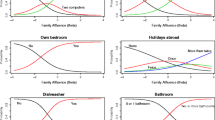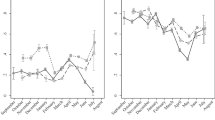Abstract
This study examined the performance of the FAS II in a general population of 17,545 students in grades 7, 9, 10 and 12 in the Atlantic provinces of Canada. The FAS II was assessed against two other measures of socioeconomic status: mother’s highest level of education and family structure. Our study found that the FAS II reduces the likelihood of nonresponse which is a common threat to the validity of items inquiring about parental income, education or occupation. Ordinal regression analysis revealed that mother’s education and family structure were independent risk factors of lesser affluence. Participants whose mother had less than a post secondary degree were 2 to 3 times more likely to report lesser affluence and those who reported living in other than 2 parent families were 1.5 to 3 times more likely to report lesser affluence. The authors conclude that the FAS II is a useful measure of socioeconomic status for this population.
Similar content being viewed by others
References
Barker, D. J. P. (1998). Mothers and babies and health in later life (2nd ed.). Churchill Livingstone: Edinburgh.
Boyce, W., Torsheim, T., Currie, C., & Zambon, A. (2006). The Family Affluence Scale as a measure of national wealth: Validation of an adolescent self-report measure. Social Indicators Research, 78, 473–487. doi:10.1007/s11205-005-1607-6.
Carstairs, V., & Morris, R. (1991). Deprivation and health in Scotland. Aberdeen: Aberdeen University Press.
Coleman, J. S. (1988). Social capital in the creation of human capital. American Journal of Sociology, 94(Suppl), S95–S120. doi:10.1086/228943.
Currie, C. E., Elton, R. A., Todd, J., & Platt, S. (1997). Indicators of socioeconomic status for adolescents: The WHO health behaviour in school-aged children survey. Health Education Research, 12, 385–397. doi:10.1093/her/12.3.385.
Dannefer, D. (2003). Cumulative advantage/disadvantage and the life course: Cross-fertilizing age and social science theory. Journal of Gerontology: Social Sciences, 58B, S327–S332.
Ensminger, M. E., Forrest, C. B., Riley, A. W., Kang, M., Green, B. F., et al. (2000). The validity of measures of socioeconomic status of adolescents. Journal of Adolescent Research, 15, 392–419. doi:10.1177/0743558400153005.
Entwisle, D. R., & Astone, N. M. (1994). Some practical guidelines for measuring youth’s race/ethnicity and socioeconomic status. Child Development, 65, 1521–1540. doi:10.2307/1131278.
Goodman, E. (1999). The role of socioeconomic status gradients in explaining differences in US adolescents’ health. American Journal of Public Health, 89, 1522–1528.
Goodman, E., Adler, N. E., Kawachi, I., Frazier, A. L., Huang, B., & Colditz, G. A. (2001). Adolescents’ perceptions of social status: Development and evaluation of a new indicator. Pediatrics, 108(2), 1–8. doi:10.1542/peds.108.2.426.
Hernandez, D. J. (1997). Child development and the social demography of childhood. Child Development, 68, 149–169. doi:10.2307/1131933.
Kuh, D., & Ben-Schlomo, Y. (2004). A life course approach to chronic disease epidemiology (2nd ed.). Oxford University Press: Oxford.
Liberatos, P., Link, B. G., & Kelsey, J. L. (1988). The measurement of social class in epidemiology. Epidemiologic Reviews, 10, 87–121.
Lien, N., Friestad, C., & Klepp, K. I. (2001). Adolescents’ proxy reports of parents’ socioeconomic status: How valid are they? Journal of Epidemiology and Community Health, 55, 731–737. doi:10.1136/jech.55.10.731.
Levine, R. A., Levine, S. E., & Schnell, B. (2001). Improve the women: Mass schooling, female literacy, and worldwide change. Harvard Educational Review, 71(1), 1–50.
Looker, D. (1989). Accuracy of proxy reports of parental characteristics. Sociology of Education, 62, 257–276. doi:10.2307/2112830.
Lowry, R., Kann, L., Collins, J. L., & Kolbe, L. J. (1996). The effect of socioeconomic status on chronic disease risk behaviors among US adolescents. Journal of the American Medical Association, 276, 792–797.
Lynch, L. W., & Kaplan, G. A. (1997). Understanding inequality in the distribution of income affects health. Journal of Health Psychology, 2, 297–314.
Newacheck, P. W., Hung, Y. Y., Park, M. J., Brindis, C. D., & Irwin, C. E., Jr. (2003). Disparities in adolescent health and health care: Does socioeconomic status matter? Health Services Research, 38, 1235–1252.
Poulin, C., Boudreau, B., & Asbridge, M. (2006). Adolescent passengers of drunk drivers: A multi-level exploration into the inequities of risk and safety. Addiction, 102, 51–61.
Poulin, C., Clarke, B., Balram, C., Wilbur, B., & Bryant, E. (1996). Student drug use surveys in the Atlantic Provinces: A standardized approach. Halifax, Nova Scotia: Dalhousie University. ISBN # 0–7703–1244–6.
Poulin, C., MacNeil, P., & Mitic, W. (1993). The validity of a province-wide student drug use survey: Lessons in design. Canadian Journal of Public Health, 84, 259–264.
Proctor, B. D., & Dalaker, J. (2002). Poverty in the United States: 2001. US Census Bureau, Current Population Reports, P60–219. Washington, DC: US Government Printing Office.
Spencer, N. (2006). Does material disadvantage explain the increased risk of adverse health, educational, and behavioural outcomes among children in lone parent households in Britain? A cross sectional study. Journal of Epidemiology and Community Health, 59, 152–157.
Spurrier, N. J., Sawyer, M. G., Clark, J. J., & Baghurst, P. (2003). Socio-economic differentials in health-related quality of life of Australian children: Results from a national study. Australian and New Zealand Journal of Public Health, 27, 27–33.
Starfield, B., Riley, A. W., Witt, W. P., & Robertson, J. (2002). Social class gradients in health during adolescence. Journal of Epidemiology and Community Health, 56, 354–361.
StataCorp. (2005). Stata statistical software: Release 9.0. College Station, TX: Author.
Statistics Canada (2001a). Population groups and sex for population, for Canada, provinces, territories, census metropolitan areas and census agglomerations, 2001 census—20% sample data. Statistics Canada Catalogue no. 97F0010XCB2001004: Ottawa.
Statistics Canada (2001b). Census of Canada. Table 95F0380XCB01005: Labour Force Activity (8), Highest Level of Schooling (11), Age Groups (11) and Sex (3) for Population 15 Years and Over, for Canada, Provinces, Territories and Forward Sortation Areas, 2001 Census - 20% Sample Data [public use data file on the Internet]. Ottawa (ON); Statistics Canada. 2001. Retrieved June 1, 2004, from the Internet Data Library System Web site: http://janus.ssc.uwo.ca.ezproxy.library.dal.ca/idls/.
Statistics Canada (2007a). Population and dwelling counts, for Canada provinces and territories, 2006 and 2001 censuses -100% data. Statistics Canada Catalogue no. 97–550-XWE2006002: Ottawa.
Statistics Canada (2007b). Census trends for Canada, provinces and territories. 2006 Census. Statistics Canada Catalogue no. 92–596-XWE. Ottawa.
Statistics Canada (2007c). Population by language spoken most often at home and age groups, 2006 counts, for Canda, provinces and territories, and census metropolitan areas and census agglomerations—20% sample data. Statistics Canada Catalogue no. 97–555-XWE2006002: Ottawa.
Statistics Canada (2007d). Median total income, by family type, by province and territory. Statistics Canada CANSIM Table 111–0009. Retrieved April 29, 2008 from: http://www40.statcan.ca/l01/cst01/famil108a.htm.
Townsend, P. (1987). Deprivation. Journal of Social Policy, 16, 125–146.
Tuinstra, J., Groothoff, J. W., van den Heuvel, W. J., & Post, D. (1998). Socio-economic differences in health risk behavior in adolescence: Do they exist? Social Science and Medicine, 47, 67–74.
von Rueden, U., Gosch, A., Rajmil, L., Bisegger, C., Ravens-Sieberger, U., the European KIDSCREEN Group (2006). Socioeconomic determinants of health related quality of life in childhood and adolescence: Results from a European study. Journal of Epidemiology and Community Health, 60, 130–135.
Wardle, J., Robb, K., & Johnson, F. (2002). Assessing socioeconomic status in adolescents: The validity of a home affluence scale. Journal of Epidemiology and Community Health, 56, 595–599.
West, P. (1997). Health inequalities in the early years: Is there equalization in youth? Social Science and Medicine, 44, 833–858.
West, P., & Sweeting, H. (2004). Evidence on equalization in health in youth from the West of Scotland. Social Science and Medicine, 59, 13–27.
Acknowledgements
This research was supported by the Canada Research Chair program as well as the Canadian Population Health Initiative [CPHI], a program of the Canadian Institute for Health Information [CIHI]. Funding for data collection was provided in part by the provincial departments of health in Nova Scotia, New Brunswick, Newfoundland and Labrador, and Prince Edward Island.
Author information
Authors and Affiliations
Corresponding author
Rights and permissions
About this article
Cite this article
Boudreau, B., Poulin, C. An examination of the validity of the Family Affluence Scale II (FAS II) in a general adolescent population of Canada. Soc Indic Res 94, 29–42 (2009). https://doi.org/10.1007/s11205-008-9334-4
Received:
Accepted:
Published:
Issue Date:
DOI: https://doi.org/10.1007/s11205-008-9334-4




